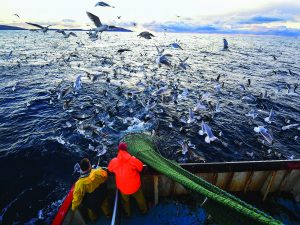 Marine life, the fish species the world over are under a serious threat due to loss of oxygen from the world’s oceans. A new report released by the International Union for Conservation of Nature (IUCN) observes that entire ecosystem is being disrupted because of diminishing oxygen.
Marine life, the fish species the world over are under a serious threat due to loss of oxygen from the world’s oceans. A new report released by the International Union for Conservation of Nature (IUCN) observes that entire ecosystem is being disrupted because of diminishing oxygen.
The review report, “Ocean deoxygenating: Everyone’s problem”, is the largest peer-reviewed study so far into the causes, impacts and possible solutions to ocean deoxygenating. Ocean regions with low oxygen concentrations are expanding, with around 700 sites worldwide now affected by low oxygen conditions — up from only 45 in the 1960s. In the same period, the volume of anoxic waters — areas completely depleted of oxygen — in the global ocean has quadrupled, according to the report.
The IUCN is a membership Union composed of both government and civil society organizations. It has more than 1300 member organisations and more than 15,000 experts. The diversity and vast expertise makes IUCN the global authority on the status of the natural world and the measures needed to safeguard it.
The report points out that at a global-scale, warming-induced oxygen loss is driving progressive persistent changes in nutrient cycling and recycling, species distributions, marine ecosystem services and habitat availability. Whereas at a regional scale, the formation of low oxygen zones and harmful algal blooms become more frequent.
In a ground-breaking new report, IUCN, in partnership with leading scientists, explore the causes, consequences and socio-economic implications of ocean deoxygenating, and discusses how we, as a planet, must react. Ocean oxygen loss, driven by climate change and nutrient pollution, is a growing menace to fisheries and species such as tuna, marlin and sharks, according to the report. With this report, the scale of damage climate change is wreaking upon the ocean comes into stark focus. As the warming ocean loses oxygen, the delicate balance of marine life is thrown into disarray.
Dr Grethel Aguilar, IUCN Acting Director General said, “The potentially dire effects on fisheries and vulnerable coastal communities mean that the decisions made at the ongoing UN Climate Change Conference are even more crucial. To curb ocean oxygen loss alongside the other disastrous impacts of climate change, world leaders must commit to immediate and substantial emission cuts.”
Dan Laffoley, Senior Advisor Marine Science and Conservation in IUCN’s Global Marine and Polar Programme, said, “We are now seeing increasingly low levels of dissolved oxygen across large areas of the open ocean. This is perhaps the ultimate wake-up call from the uncontrolled experiment humanity is unleashing on the world’s ocean as carbon emissions continue to increase. Ocean oxygen depletion is menacing marine ecosystems already under stress from ocean warming and acidification. To stop the worrying expansion of oxygen-poor areas, we need to decisively curb greenhouse gas emissions as well as nutrient pollution from agriculture and other sources.”
Deoxygenating is starting to alter the balance of marine life , favouring low-oxygen tolerant species (e.g. microbes, jellyfish and some squid) at the expense of low-oxygen sensitive ones (many marine species, including most fish).
Some of the ocean’s most productive biomes — which support one fifth of the world’s wild marine fish harvest — are formed by ocean currents carrying nutrient-rich but oxygen-poor water to coasts that line the eastern edges of the world’s ocean basins. As naturally oxygen-poor systems, these areas are particularly vulnerable to even small changes in ocean oxygen. Impacts here will ultimately ripple out and affect hundreds of millions of people.
Species groups such as tuna, marlin and sharks are particularly sensitive to low oxygen because of their large size and energy demands. These species are starting to be driven into increasingly shallow surface layers of oxygen-rich water, making them more vulnerable to overfishing. Very low ocean oxygen can also affect basic processes like the cycling of elements crucial for life on Earth, such as nitrogen and phosphorous, the report warns.
The ocean is expected to lose 3–4 per cent of its oxygen inventory globally by the year 2100 under a business-as-usual scenario, but the global average masks local changes that are predicted to be, for example, more severe in mid to high latitudes. Most of the losses are predicted to be concentrated in the upper 1000m of the water column, which is richest in marine biodiversity.
The major drivers of ocean oxygen loss are climate change and nutrient pollution, with the latter affecting coastal areas. As the ocean warms, its waters hold less oxygen and become more buoyant, resulting in reduced mixing of the oxygen-rich water near the surface with the ocean depths, which naturally contain less oxygen. Nutrient pollution causes oxygen loss in coastal waters as fertiliser, sewage, animal and aquaculture waste cause excessive growth of algae, which in turn deplete oxygen as they decompose.
The report suggests that urgent global action to overcome and reverse the effects of ocean deoxygenating is needed. World leaders will also come together in June 2020 at the IUCN World Conservation Congress in Marseille to drive action towards restoring ocean health – one of the key themes of the next IUCN Congress.
The IUCN has in the report found that over 6,000 species are critically endangered. “There are literally thousands of species which could go extinct by 2030 as many are very much on the brink.” It says that the “Earth is experiencing an extinction crisis and governments worldwide are failing to respond appropriately. It is important to save animals from extinction because our fate is tied directly to theirs.”
Some of the species most at risk of dying out before 2030 are herbivorous mammals like Sumatran Rhino. They were once found in the Eastern Himalayas in Bhutan and eastern India, Myanmar, Thailand, Vietnam and China. In 1986, an estimated 800 Sumatran Rhinos lived in the wild, according to save the Rhino. The number came down to 275 in 2008 and now their number could be less than 100. Several fish species have already become extinct.
Indian efforts
In India, the Union Government has taken some steps to protect the endangered species. These include, legal protection of wild animals against hunting and commercial exploitation under the provisions of the Wild Life (Protection) Act, 1972. The Wild Life (Protection) Act 1972 has been amended and made more stringent. The punishment for offences under the Act has been enhanced.
Protected Areas, viz., National Parks, Sanctuaries, Conservation Reserves and Community Reserves covering important wildlife habitats have been created all over the country under the provisions of the Wild Life (Protection) Act, 1972 to conserve wild animals and their habitats. The Wildlife Crime Control Bureau has been set up to strengthen the enforcement of law for control of poaching and illegal trade in wildlife and its products.
The Ministry of Environment & Forests also provides financial assistance to State Governments for undertaking “recovery programmes for saving critically endangered species” as a component of the Centrally Sponsored Scheme of ‘Integrated Development of Wildlife Habitats’.
At present, sixteen species have been prioritized for taking up such recovery programmes which include Snow Leopard, Bustards (including Floricans), River Dolphin, Hangul, Nilgiri Tahr, Marine Turtles, Dugongs and coral reefs, Edible-nest Swiftlets, Asian Wild Buffalo, Nicobar Megapode, Manipur Brow-antlered deer, Vultures, Malabar civet, the great one-horned rhinoceros, Asiatic Lion, Swamp deer and Jerdon’s Courser.
letters@tehelka.com












